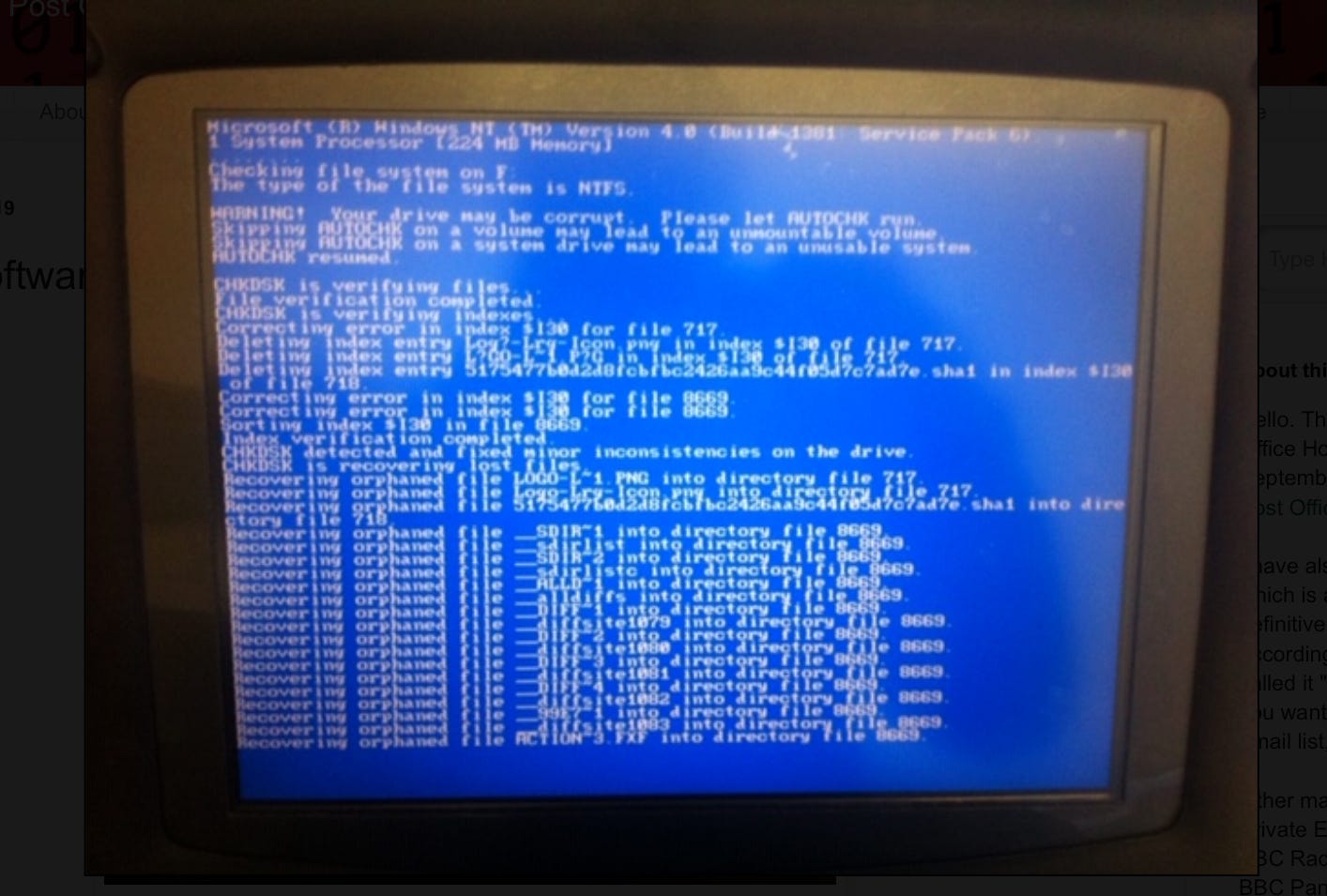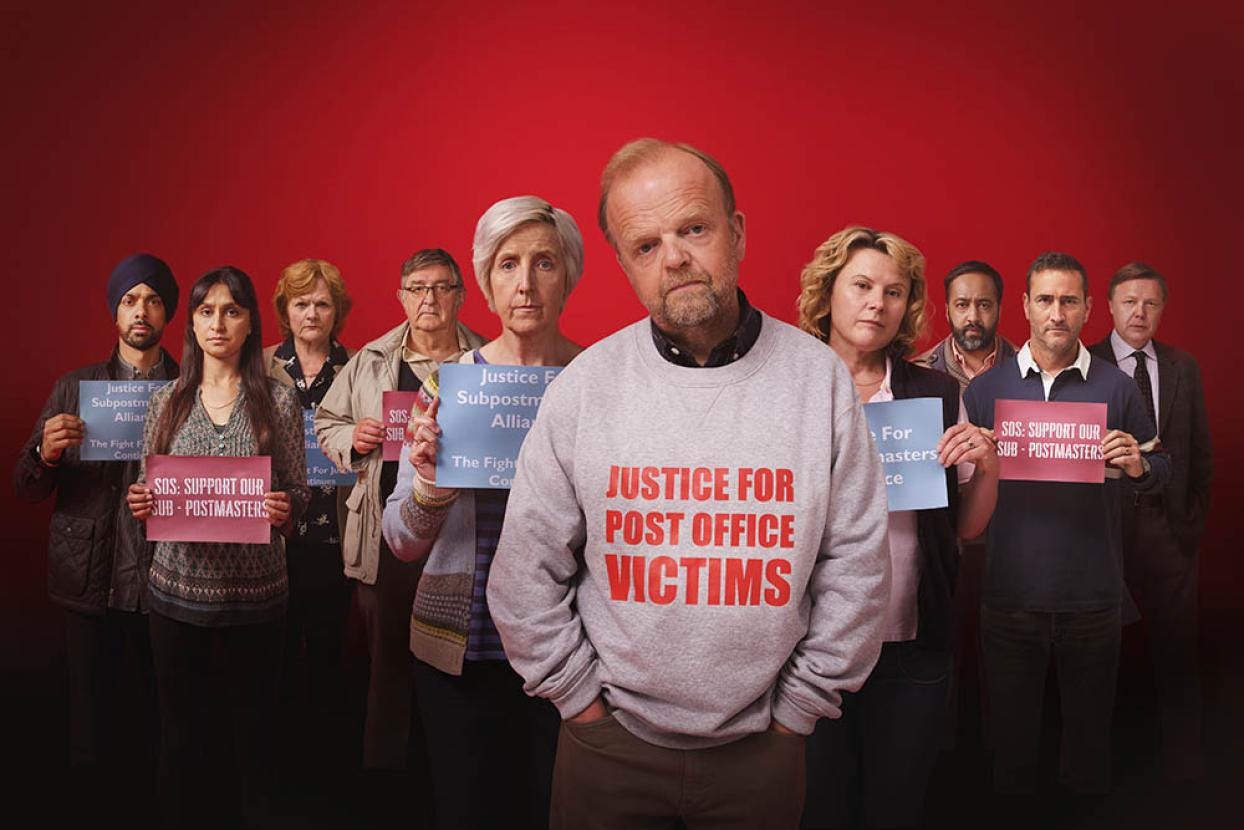8 January 2024. Post Office | Collapse
How the British Post Office gaslighted its workforce. // We might be learning the wrong lessons from narratives of collapse
Welcome to Just Two Things, which I try to publish three days a week. Some links may also appear on my blog from time to time. Links to the main articles are in cross-heads as well as the story. A reminder that if you don’t see Just Two Things in your inbox, it might have been routed to your spam filter. Comments are open.
1: How the British Post Office gaslighted its workers
I spent some of last week watching the four-part ITV drama Mr Bates vs the Post Office, about the UK Post Office scandal, which may be Britain’s largest ever single miscarriage of justice. I also watched the accompanying documentary. Credit to ITV, the UK’s biggest commercial television network, for committing the resources to give this shocking story, which has unfolded over more than two decades, the visibility it deserves.
The trailer gives a flavour of it:
I thought I knew the story pretty well, but in truth I didn’t know the half of it. For readers overseas, it might be worth rehearsing some of the rather complex history, as simply as possible.
The Post Office is the part of the British postal system that runs its network of several thousand post office branches. A small number of larger post offices are operated directly, but most are “sub-post offices”, usually run by individuals on a franchise basis. Their contract states that they are responsible for any losses.
Until 1999, sub-post masters would balance their books by hand. The Post Office then introduced a computerised system, called Horizon, designed and run by the computer company Fujitsu. This was a spin-off from a larger (abandoned) government computerisation project which the Post Office had been involved in.
It was the biggest computer project in Europe, and effectively it hard-wired every sub-post office in the country to a central Fujitsu mainframe. The Horizon computer software was also riddled with bugs and errors, and the Post Office was aware of this at least from 2002. This shouldn’t have been a surprise: “big computer system has bugs” is not news. But the Post Office spent more than fifteen years insisting that the system was “robust”.
From the early days of the roll-out, some postmasters discovered that the Horizon system was telling them that they had losses. This was a big deal, because they were personally liable for this. Anyone who rang the Horizon helpline was told—this was a lie—that they were the only sub-postmaster having this problem.
As one of the reviews of the drama series said,
there were many hundreds of people who found themselves being gaslit by a helpline.
And then the Post Office’s investigations division started to kick in. People had their contracts terminated; some (more than 700) were prosecuted, sometimes for false accounting, sometimes for theft or fraud. Sometimes a fraud or a theft charge was used as a shakedown to get someone to plead guilty to the more minor charge of false accounting and agree to repay the “missing” money. Some were deliberately bankrupted to discourage others from seeking justice.
As the earlier review said,
thousands of subpostmasters were accused of financial mismanagement, hundreds were prosecuted... and countless lives were devastated.
Because one of the quirks of the Post Office is that, unusually, it can bring its own prosecutions. Eventually—after years of organising by the Justice for Sub-Postmasters’ Alliance (JSA), and in the face of lies, delays, obstruction and obfuscation by the Post Office—those damaged by all of this have started to have their convictions overturned, some posthumously, and some compensation payments have started to be made, even if all of this is progressing far too slowly.
During most of this time the Post Office insisted—this was another lie—that it was impossible to access an individual sub-postmaster’s account from outside. But Fujitsu engineers were doing this all the time, as they tried to fix the endless bugs, glitches, and errors in the system. This only came out in a court case, much later.
(A malfunctioning Horizon terminal. Source: Post Office Trial blog.)
There’s a lot going on here, and it is inevitably hard to follow. The best single summary is at Computer Weekly, which was the first to report on the story in 2008. Or, if you absorb information better by video, Hudgell Solicitors, which has represented many of the sub-postmasters, has a 30-minute video.
I’m interested in a number of things here. The first is that this is a case study in what happens when a organisation goes feral. There are obvious questions about governance, incentives, management systems, and the complete lack of organisational curiosity. There’s a strategy question as well, since the Post Office is completely dependent on its sub-postmaster network. And there’s also a question of what was going on at a deeper level, since the list above is clearly a set of symptoms. I’ll come back to these in a second post. (And probably a third).
But today I’m just going to touch on how the Post Office managed to get away with gaslighting their own sub-postmasters for so long. Researchers who have been studying this had an article in The Conversation that identified four reasons, based on public transcripts and research interviews.
The first is the lie about “being the only one”, which may have been part of the Horizon helpline scripts:
(O)ne witness, Katherine McAlerney, representing the experiences of many when she said: “I was told during my interview that I was the only one who had a problem like this with the system.”
The researchers found this repeatedly—it took years before the wronged sub-postmasters were able to turn themselves into a cohesive group:
Being told they were the only one not only discouraged victims from speaking out, it also planted a seed of self-doubt in many of their minds... This cycle of isolation and self-doubt helps explain why most did not attempt to find other possible victims or try to speak out publicly about the injustice.
The second was the anger in many of their communities in the face of the financial allegations against them and the legal action:
Our analyses of the public inquiry statements reveal the local stigmatisation and shame that many felt. There are vivid accounts of sub-postmasters being spat on , shouted at and shunned... We have also collected and analysed local news reports on the early accusations. Common themes include describing the allegations as “stealing from pensioners” or “having their hand in the till”... This sense of shame is just the tip of the iceberg in terms of the negative mental health effects that sub-postmasters experienced from being wrongfully accused.
The third is that victims were unable to defend themselves. The minute that they were suspended from their role by Post Office investigators, they had no access to anything that would allow them to make a case for their innocence:
Imagine that, tomorrow morning, you walk into work and are called into your line-manager’s office. They accuse you of something and tell you to gather your personal items as you are being sacked. You try to reassure them you’ve done nothing wrong, and you know that if you can access some files on your computer, you can clear it all up. But when you go to your desk, you see that your computer is gone, along with your access to all your IT systems, emails, documents and archived electronic files.
This is, in effect is what happened to the accused sub-postmasters, and it clearly breaches a basic principle of procedural fairness.
The last point is that at the time, the Post Office was one of Britain’s most trusted brands. The result of this was that sub-postmasters didn’t think they would be believed. There’s a telling quote from one of their interviews with a victim, Nicola Arch:
Working for the Post Office, it was the Queen’s business. It was very respected, very highly regarded. The Queen acknowledges the Post Office — her face is on the stamps. In that era, everyone believed that it was a very prestigious company to work for, very respected … Everyone thought the Post Office could never be wrong.
(The cast of Mr Bates vs The Post Office show solidarity. Source: ITVX)
If you’re in the UK, you can still watch Mr Bates vs The Post Office on ITV’s streaming service ITVX.
There’s also a statutory public inquiry which is investigating the scandal. The best day-to-day coverage of that is at the Post Office Scandal site—a blog run by Nick Wallis, a journalist who has been closely involved in the story.
2: We might be learning the wrong lessons from narratives of collapse
I spent some of my holiday period writing an article about theories of collapse for the Association of Professional Futurists’ newsletter Compass. That’s not quite published yet, although I’ll mention it when it does appear, since Compass is open access these days.
My initial draft was a bit long, and so I needed to cut something (“Kill your darlings”, as the rather aggressive advice to writers used to put it.)
The darling that eventually got excised from the article was a section about the narratives of collapse. I’ve expanded that section a bit here for Just Two Things. Because although there’s plenty of research that suggests that collapse is a normal part of systems behaviour—see, for example, the ‘panarchy’ model—the narratives about collapse seem to both fascinate us and repel us. How else do we explain the still endless discussions, at least in Europe and America, about the collapse of the Roman Empire?
One of the best recent books on collapse is by the archaeologist Guy Middleton. Understanding Collapse starts with Middleton listening to a radio news report about the collapse of the Mayan Empire, as unlikely as that sounds.
The whole report probably lasted no more than two or three minutes, an impressively short time in which to explain the fate of a long-lived and complex civilisation that had existed for hundreds of years, several times longer than modern nations like the United States or Australia... But I wondered what exactly I and other listeners were supposed to understand by 'collapse' and by "Maya civilisation' - dramatic images of lost and abandoned cities reclaimed by nature were evoked, but would we all be imagining the same thing?
As he reflects on this, he decides that collapse stories “appeal to our narrative desires”. This is happening at two levels. First, there are the researchers, who are on a kind of ‘quest romance’:
What such stories really represent is a kind of quest romance, a kind of story as ancient and appealing as the oldest stories we know, which historian Ronald Hutton explains is 'one of the most popular and effective modes of expression for historical or archaeological research'. Researchers are heroes on a quest, who undergo a journey in which they apply their knowledge and skills, and eventually, and triumphantly, solve a seemingly insoluble historical conundrum.
There’s a reason, in other words, why Indiana Jones was an archaeologist. There’s a second level here as well: stories of collapse are both tragedy and parable.
In a tragedy, the flaws of the hero lead to their downfall. A tragedy is also a social narrative, recorded in a play, book, or film: “our stories of collapse are spectacles, shared and consumed by modern audiences.” Although there is any number of recent films telling collapse stories, from Contagion and 28 Days to The Road and The Day After Tomorrow, some of our deep myths are about collapse.
Flood stories are told in The Epic of Gilgamesh, the Old Testament, and other cultures, and the Bible also recounts the destruction of Sodom and Gomorrah. The story of Atlantis was invented by Plato, and has been taken ever since as a cautionary tale, even though he doesn’t seem to have meant it that way. The end of Pompeii was portrayed in a successful travelling show in the 19th century, promoted by the Pain family, who made fireworks. FN I spent a summer working in their factory near Salisbury once upon a time.
An article by Alessandro Fergnani and Zhaouli Song has built on this idea of the role that films play here, by constructing archetypes based on films set in the future. (The article, in Futures, is outside of the paywall). So they’re also building on Jim Dator’s four futures archetypes as well.
They found that all six had elements of crisis in them, either imminent, immanent, or extant.
Two of the archetypes, in particular, are variants on Dator’s Collapse. ‘Wasteworlds’, whose reference films include Mad Max and Wall-E, are set in the aftermath of collapse; ‘Disarray’ portrays the collapse process in the making. (Reference films include Dredd and Children of Men.)
In Wasteworlds:
In this archetype, a catastrophic event or phenomenon has already occurred, bringing about substantial transformations on a global scale... Often times, on the backdrop of severe resources’ scarcity, human civilization has regressed to sustenance level. The market economy has given way to more rudimentary economic systems, such as barter or the use of water, oil, or sand as currencies. Few survivors live in scattered tribal communities, struggling for life and often exploited by gangs of outlaws.
Disarray is a little nicer, but not much:
In this archetype, although in absence of apparent transformational changes in the economy or atmospheric environment, mankind faces structural endogenous problems. The globe is plagued by any of the following: endemic crime, social unrest and disorder, widespread poverty, ignorance, infertility, violent confrontation and war, famines, or pandemics; or by a combination of these... Individual endeavors zero in on restoring or maintaining justice , order, or protection of citizens.
It’s an interesting article, and an interesting idea, although I have some reservations about it. Yes, films set in the future are images of the future. But images of the future that are sufficiently narratively compelling to be greenlighted by a Hollywood studio seems to me to skew the sample. Sustainability and resilience, of course, make for less entertaining movies.
(The much maligned Easter Island. Photo: Phil Whitehouse/flickr. CC BY 2.0)
And Guy Middleton sounds a cautionary note in an article he wrote in Aeon on his research. He observes that many of our narratives of collapse currently are about climate change, and that’s because collapse stories reflect our own current anxieties. But the archeological record suggests instead that in many cases collapse has followed contact. To take one example, in the case of the much-maligned Easter Islanders, used by Jared Diamond in his book Collapse as a story of environmental self-destruction, “it was, once again, outsiders who brought disaster and change”.
As Middleton concludes,
We do not need to make other peoples’ histories into lessons for ourselves. When the evidence for environmentally driven collapses in the past is so weak, and the evidence for contact-era atrocities so strong, it is a wonder that the former is the focus and the lesson, rather than the latter. Perhaps we should be asking ourselves what exactly we should be learning from history.
j2t#530
If you are enjoying Just Two Things, please do send it on to a friend or colleague.






